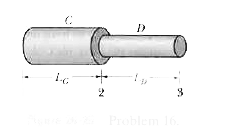Four spheres made of different materials but having the same mass, have a radii of 100 mm, 2×10−2m, 30 cm and 10−5km then arrange them in ascending order of their volumes.
The correct Answer is:V4<V2<V1<V3
Volume of a sphere, V=43πr3
V∝r3
r1=102mm=10−1m
r2=2×10−2=2×10−2m
r3=30×10−2m=3×10−1m
r4=10−5×103m=10−2m
V4<V2<V1<V3
Topper's Solved these Questions
- BOOK - PEARSON IIT JEE FOUNDATIONCHAPTER - MEASUREMENTS AND MOTIONEXERCISE - CROSSWORD2videos
MEASUREMENTS AND MOTION
- BOOK - PEARSON IIT JEE FOUNDATIONCHAPTER - MEASUREMENTS AND MOTIONEXERCISE - CONCEPT APPLICATION5videos
MEASUREMENTS AND MOTION
- BOOK - PEARSON IIT JEE FOUNDATIONCHAPTER - LIGHTEXERCISE - ASSESSMENT TEST (CROSS WORD )11videos
LIGHT
- BOOK - PEARSON IIT JEE FOUNDATIONCHAPTER - MOVEMENT - AN AMAZING ACTIVITY EXERCISE - CROSSWORD1videos
MOVEMENT - AN AMAZING ACTIVITY
Similar Questions
Four spheres made of different materials but having the same mass, have a radii of 100 mm, 2×10−2m, 30 cm and 10−5km then arrange them in ascending order of their volumes.
View SolutionTwo spheres made of different materials but having the same mass, hace radii in the ratio of 3 : 4. Find the ratio of their densities.
View Solution
Knowledge Check
- Question 1 - Select One
Two homogeneous spheres P and Q of different materials and masses 1 kg and 2 kg are kept in contact. The radii of A and B are 20 cm and 10 cm respectively. What is the distance of their centre of mass from the centre of A?
A0.1mB0.15mC0.2mD0.25m - Question 2 - Select One
Two solid spheres of different materials have the same moments of inertia about their diameters. If r1 and r2 are their radii, ratio of their densities is
Ar31:r32Br32:r32Cr51:r52Dr52:r51 - Question 3 - Select One
A circular plate, a cube and a sphere, all made up of same material and having the same mass, are heated to 300∘C and left in a room. Which of them will have the slowest rate of cooling?
ACircular plateBCubeCSphereDAll will cool at the same rate
Two spheres made of different materials but having the same mass, hace radii in the ratio of 3 : 4. Find the ratio of their densities.
View SolutionTwo spheres made of different materials have their masses in the rato of 1:2. If the diameter of the first sphere is equal to the radius of the second sphere, tehn determine the ratio dinsities volume of
sphere = 43πr3View SolutionTwo spheres made of different materials have their masses in the rato of 1:2. If the diameter of the first sphere is equal to the radius of the second sphere, tehn determine the ratio dinsities volume of
sphere = 43πr3View SolutionWire C and wire D are made from different materials and have length LC=LD=1.0m. The resistivity and radius of wire C are 2.0×10−6.Ωm and 1.00 mm, and those of wire D are 1.0×1.0−6Ω.m. and 0.50 mm. The wires are joined as shown in Fig. 26-25, and a current of 2.0 A is set up in them. What is the electric potential difference between a) points 1 and 2 and (b) points 2 and 3? What is the rate at which energy is dissipated between c) points 1 and 2 and (d) points 2 and 3?
 View Solution
View SolutionTwo sphere made of the same material have their radii in the ratio of 2:1. What is the ratio of the radiant energy emitted per second by them if both of them are at the same temperature ?
View Solution

